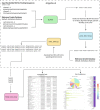GOgetter: A pipeline for summarizing and visualizing GO slim annotations for plant genetic data
- PMID: 37601315
- PMCID: PMC10439822
- DOI: 10.1002/aps3.11536
GOgetter: A pipeline for summarizing and visualizing GO slim annotations for plant genetic data
Erratum in
-
Correction to GOgetter: A pipeline for summarizing and visualizing GO slim annotations for plant genetic data.Appl Plant Sci. 2023 Sep 2;11(5):e11544. doi: 10.1002/aps3.11544. eCollection 2023 Sep-Oct. Appl Plant Sci. 2023. PMID: 37915434 Free PMC article.
Abstract
Premise: The functional annotation of genes is a crucial component of genomic analyses. A common way to summarize functional annotations is with hierarchical gene ontologies, such as the Gene Ontology (GO) Resource. GO includes information about the cellular location, molecular function(s), and products/processes that genes produce or are involved in. For a set of genes, summarizing GO annotations using pre-defined, higher-order terms (GO slims) is often desirable in order to characterize the overall function of the data set, and it is impractical to do this manually.
Methods and results: The GOgetter pipeline consists of bash and Python scripts. From an input FASTA file of nucleotide gene sequences, it outputs text and image files that list (1) the best hit for each input gene in a set of reference gene models, (2) all GO terms and annotations associated with those hits, and (3) a summary and visualization of GO slim categories for the data set. These output files can be queried further and analyzed statistically, depending on the downstream need(s).
Conclusions: GO annotations are a widely used "universal language" for describing gene functions and products. GOgetter is a fast and easy-to-implement pipeline for obtaining, summarizing, and visualizing GO slim categories associated with a set of genes.
Keywords: annotation; data mining; gene function; gene ontology.
© 2023 The Authors. Applications in Plant Sciences published by Wiley Periodicals LLC on behalf of Botanical Society of America.
Figures


Similar articles
-
Correction to GOgetter: A pipeline for summarizing and visualizing GO slim annotations for plant genetic data.Appl Plant Sci. 2023 Sep 2;11(5):e11544. doi: 10.1002/aps3.11544. eCollection 2023 Sep-Oct. Appl Plant Sci. 2023. PMID: 37915434 Free PMC article.
-
A drug target slim: using gene ontology and gene ontology annotations to navigate protein-ligand target space in ChEMBL.J Biomed Semantics. 2016 Sep 27;7(1):59. doi: 10.1186/s13326-016-0102-0. J Biomed Semantics. 2016. PMID: 27678076 Free PMC article.
-
GOcats: A tool for categorizing Gene Ontology into subgraphs of user-defined concepts.PLoS One. 2020 Jun 11;15(6):e0233311. doi: 10.1371/journal.pone.0233311. eCollection 2020. PLoS One. 2020. PMID: 32525872 Free PMC article.
-
How to learn about gene function: text-mining or ontologies?Methods. 2015 Mar;74:3-15. doi: 10.1016/j.ymeth.2014.07.004. Epub 2014 Aug 1. Methods. 2015. PMID: 25088781 Review.
-
Gene Ontology annotation of the rice blast fungus, Magnaporthe oryzae.BMC Microbiol. 2009 Feb 19;9 Suppl 1(Suppl 1):S8. doi: 10.1186/1471-2180-9-S1-S8. BMC Microbiol. 2009. PMID: 19278556 Free PMC article. Review.
Cited by
-
Graphical pangenomics-enabled characterization of structural variant impact on gene expression in Brassica napus.Theor Appl Genet. 2025 Apr 3;138(4):91. doi: 10.1007/s00122-025-04867-2. Theor Appl Genet. 2025. PMID: 40178590 Free PMC article.
-
Arabidopsis as a model for translational research.Plant Cell. 2025 May 9;37(5):koae065. doi: 10.1093/plcell/koae065. Plant Cell. 2025. PMID: 38411602 Free PMC article. Review.
References
-
- Altschul, S. F. , Gish W., Miller W., Myers E. W., and Lipman D. J.. 1990. Basic local alignment search tool. Journal of Molecular Biology 215: 403–410. - PubMed
-
- Barker, M. S. , Kane N. C., Matvienko M., Kozik A., Michelmore R. W., Knapp S. J., and Rieseberg L. H.. 2008. Multiple paleopolyploidizations during the evolution of the Compositae reveal parallel patterns of duplicate gene retention after millions of years. Molecular Biology and Evolution 25: 2445–2455. - PMC - PubMed
LinkOut - more resources
Full Text Sources
Research Materials

